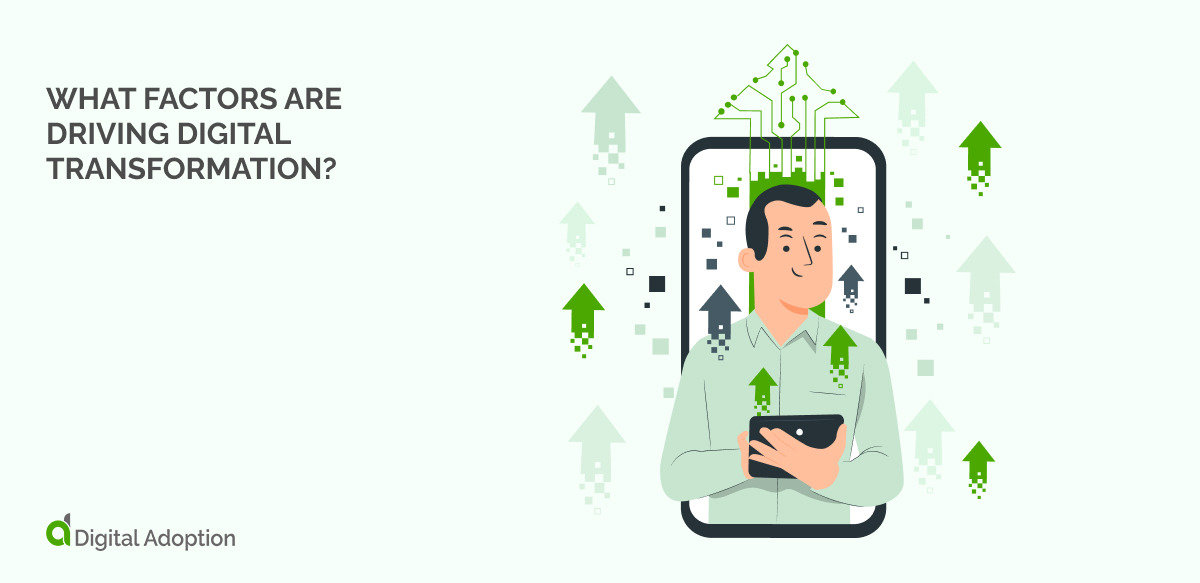Digital transformation is taking over the world.
New innovations have driven digital transformation across the global economy. Every industry, every business, could benefit from digital transformation— we know it, and you know it.
But sometimes that’s not enough.
Whether you’re putting together digital transformation proposals or creating content, you need to see the proof in the pudding.
One of the biggest challenges you’ll face on your digital transformation journey is resistance to change— and this page is your secret weapon to overcoming that hurdle.
We’ve created this article, full to the brim with digital transformation statistics updated for 2023, so you can see the irrefutable truth:
That digital transformation is one of the most powerful ways to drive business growth.
And because we know you’re curious— rest assured that every digital transformation statistic on this page is from 2020 or later, and we’ve linked the original source.

The current state of digital transformation:
This list of statistics will give you insight into what other businesses are doing with digital transformation.
Whether they’re your competitors or the biggest businesses in the world, here’s how they’re using digital transformation:
- 91% of businesses are engaged in some form of digital initiative (Gartner)
- 40% of organizations have brought digital initiatives to scale (Gartner)
- 89% of all companies have already adopted or plan to adopt a digital-first business strategy. (Foundry)
- The global digital transformation market is expected to grow to $1,009.8 billion by 2025 from $469.8 billion in 2020 (GlobalNewswire)
- The digital transformation market size is projected to grow at a compound annual growth rate of 19.1%, from $521.5 billion in 2021 to $127.5 billion in 2026 (MarketsAndMarkets)
- Global digital transformation spending is projected to reach 3.4 trillion U.S. dollars by the year 2026. (Statista)
- $100 trillion will be added to the world economy through digital transformation by 2025. (World Economic Forum)
- Fewer than 1 percent of surveyed business executives said their organizations had yet to start on cloud computing and legacy modernization. (InfoSys)
What factors are driving digital transformation?

Why is digital transformation so important? What are the key reasons business leaders are pushing for action?
This list of statistics will illustrate the biggest drivers of digital transformation in today’s business landscape:
- 87% of senior business leaders say digitalization is a priority (Gartner)
- 51% of digital transformation efforts are fueled by market pressure and growth opportunities (Prophet)
- 76% of businesses plan on long-term IT changes as a result of COVID-19 (SWZD)
- Top strategic tech trends that will drive disruption and growth include hyperautomation, multi-experience, democratization, and human augmentation, among other things (Gartner)
- Becoming a “composable business” could help you outpace competitors by 80% in the speed of implementing new features. (Gartner)
- 51% of digital transformation efforts arise from growth opportunities and 41% from increased competitive pressure. (Prophet)
- 57% of organizations believe digital transformation will impact workplace transformation more than physical (38%) and cultural (15%) elements. (InfoSys)
Digital transformation statistics: Best practices
If you’re thinking about your own digital transformation, you should take a moment to peruse these statistics.
They all relate to the best way to do things:
- 28% of digital transformation initiatives are often owned or sponsored by CIOs, with 23% of CEOs increasingly playing a leadership role. (Prophet)
- 70% of businesses chose to increase or maintain digital transformation spend during the pandemic (IFS)
- 97% of IT decision-makers are involved in digital transformation initiatives (MuleSoft)
- By 2024, 25% of CIOs at large enterprises will become accountable for digital business operational results, or “COO by proxy” (Gartner)
- In 70% of surveyed organizations, using tech to simplify workflows and manual processes is the top priority. (OpenText)
- Businesses prioritizing cultural transformation are 5X more likely to achieve breakthrough performance than those not. (BCG)
- The majority of firms are turning to digital solutions to address environmental sustainability. (Deloitte)
Digital transformation for and medium enterprises

Digital transformation isn’t just for big businesses.
If you’re a small or medium-sized business owner, you could also reap the rewards of digital transformation.
Here are some stats to support that statement:
- 60% of the midsize enterprise workload will remain on-premise through 2025. (Gartner)
- 57% of small business owners feel they must improve their IT infrastructure to optimize their operations. (YourStory)
- 51% of SMEs rely on Social Media to grow businesses (DoodleBlue)
- 92% of SMEs believe digital transformation is crucial for their business. (MDPI)
Failures and challenges in digital transformation

Digital transformation isn’t sunshine and roses all the time, every day. It comes with its fair share of risks.
Sometimes it doesn’t go right, but a wise business leader learns from their mistakes and the mistakes of others.
This list of digital transformation statistics will help you do just that:
- Despite aligned leadership, 70% of digital transformation projects fall short of their goals. (Forbes)
- Only 16% of employees believe their company’s digital reforms have enhanced productivity and are long-term sustainable. (Mckinsey)
- 42% of employees say they lack vital office supplies at home, and the internet connection for 1 in 10 employees is not good enough to get their work done. (HBR)
- One-third of organizations will fail at their first attempt at anywhere working. (Forrester)
- 50% of the elderly reported a lack of knowledge, and one-third a lack of confidence in using devices. (Pew Research Center)
- 82% of IT security and C-suite executives had at least one data breach attributable to digital transformation. (Ponemon)
- Nearly 75% of workers do not feel equipped to learn the digital skills needed in today’s workplace. (Salesforce)
Digital transformation statistics: The immutable truth

Digital transformation is crucial if you want to keep up with the roiling change of today’s increasingly digital landscape. That’s what these statistics show. The data also demonstrates that companies investing in digital transformation will have a better chance of succeeding, staying profitable, and leading in their industries. Conversely, leaders who fail to keep up with digital trends will have a much more difficult time in the years ahead. If you want to drive business growth and see your ideas flourish in 2024 and beyond, now is the time to iron out your digital strategy.







![18 Examples of AI in Finance [2025]](https://www.digital-adoption.com/wp-content/uploads/2025/06/18-Examples-of-AI-in-Finance-2025-300x146.jpg)
![14 Examples of AI in Manufacturing [2025]](https://www.digital-adoption.com/wp-content/uploads/2025/06/14-Examples-of-AI-in-Manufacturing-2025-300x146.jpg)




